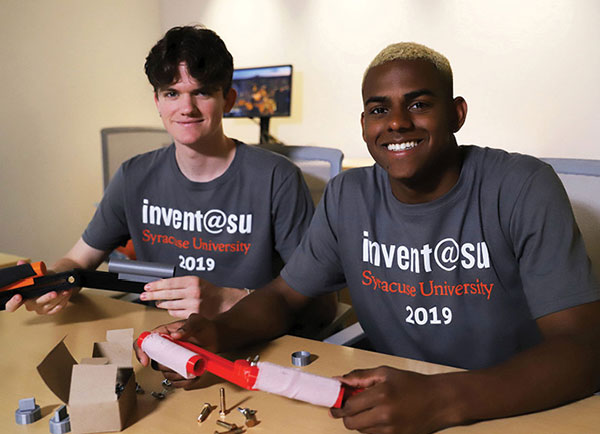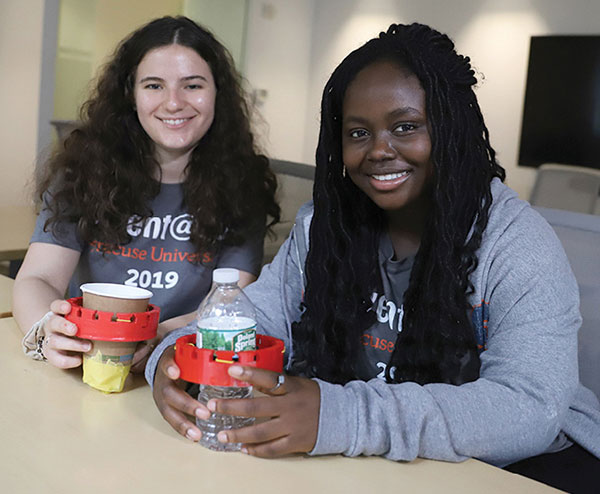
Porta-Splint, which placed first in the 2019 competition, is a portable, collapsible emergency splint system to enable users to be medically prepared for any outdoor environment. Image courtesy of Syracuse University.
Latest News
April 15, 2021
The Invent@SU program is the progeny of the Invention Factory program that began at The Cooper Union in 2013. The founders, Alan Wolf and Eric Lima, oversaw cohorts of 20 engineering students through a six-week process of ideating, prototyping, pitching, provisional patent application filing and competing. Students accepted into the program receive a stipend to participate in the intensive program that runs full-time.
Louise R. Manfredi, assistant professor of industrial and interaction design and lead for Syracuse University’s Invent@SU student invention accelerator program, spoke to us about the program.
Digital Engineering: Can you provide an overview of the Invent@SU competition, how it came to be and the intent of the program? Who will be participating or who has participated?
Dr. Manfredi: The program was introduced to Syracuse University in 2017 and has evolved to develop a stronger focus on interdisciplinary collaboration amongst students from any discipline, led by faculty with equally diverse expertise. The intent of the program is to give students the opportunity to focus on developing an innovative idea without the stress of studying at the same time. With financial support, they can devote six full weeks to experimenting and learning with and from their peers of different disciplines.
Some teams come in with an idea to pursue, and others join us to find a niche. Either way, it is wonderful to see them work through the ups and downs of the design process and ultimately present a patentable invention on judging day. Since 2017, the program has run from two locations—campus and New York City.
Students self-formed into two-person teams and brainstorm to find a problem area. At the end of the first week, students pitched a need-based design.
During weeks two through five, students receive a $1,000 budget per team to prototype. As they iterate, they pitch weekly to an audience of alumni and faculty to receive suggestions for design and narrative improvements. The pitches are filmed and critiqued by the faculty and acting coach the following day. Students also work on their provisional patent applications during this period, which helps them to iron out all their product features and functions.
In week six, students file provisional patent applications with the U.S. Patent and Trade Office and pitch their invention to a judging panel comprising trustees and successful entrepreneurial alumni. The judging panel then awards the $5,000 first-place prize and $3,000 second-place prize.
We were looking forward to working with our 2020 cohort over the summer, but, unfortunately, we were unable to run the program during a global pandemic. We are, however, planning a big comeback for 2021 with a revamped program structure that promotes interdisciplinary teamwork and a more user-centered design approach, plus an expanded prize structure.
DE: Can you tell us about some of the designs that are part of the event and how they came to be?
Manfredi: We have supported some excellent design innovations in the past four years, and our students have enjoyed success beyond the program.
In 2019 Nikita Chatterjee (economics, ’20) and Briana Howard (public health, ’20) developed a low-tech sari water filter for women in the slums of India and have since been developing their product and providing support for people in India during the COVID-19 pandemic.
SugEx, a glucose monitoring watch developed by Russell Fearon (engineering and computer science, ’20) and Ricardo Sanchez (industrial and interaction design, ’21), has had extraordinary success by winning $55,000 from the American Heart Association’s National EmPOWERED to Serve [program for] the business plan competition. They are developing their product further.

DE: Can you provide some examples of what the event has produced or what you expect it to produce?
Manfredi: Inventions aside, this program has provided students with a unique experience that they would not have received in their regular curriculum. The feedback has been incredibly encouraging, and we use this to continually improve the program.
From a broader perspective, the goal of the program is to catalyze an interdisciplinary mindset in our students that is needed to solve global engineering, which has led to the development of scholarly research in interdisciplinary professional identity.
The United Nations Sustainable Development Goals for 2030 are a stark reminder of the fragility of humanity. With 30 distinct complex challenges that require immediate attention, of which 14 the National Academy of Engineering identifies as engineering centric, the profession has mounting expectations leveled upon it to make an impact. Insight from multiple disciplines is needed to understand the complexity of these problems; therefore, graduating engineers need to be prepared for interdisciplinary collaboration.
For engineers to have meaningful impact on solving these challenges, new ways of thinking and learning need to be developed. It is no longer enough to have technical competencies—an interdisciplinary mindset and skills base are required.
A program of research is being developed to understand identity development during and after participating in Invent@SU. The goal is to develop a better understanding of how engineering identity needs to evolve to encompass new competencies in design thinking, interdisciplinary collaboration and appreciation for other disciplines in complex problem-solving.
Subscribe to our FREE magazine, FREE email newsletters or both!
Latest News
About the Author
Jim Romeo is a freelance writer based in Chesapeake, VA. Send e-mail about this article to [email protected].
Follow DE





